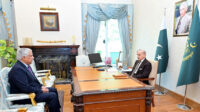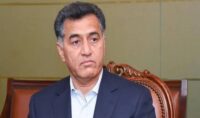The blue economy goes beyond the idea of utilizing the ocean for economic prosperity only. It focuses on blue growth, preservation of the marine ecosystem, improvement of livelihood and providing opportunities for jobs. In 2010, Gunter Pauli introduced the concept of the blue economy in his book, “The Blue Economy: 10 years, 100 innovations, 100 million jobs”. The books emphasize that the blue economy is the sustainable use of ocean resources and the conservation of marine health and ecosystem.
Water covers 71% of Earth total surface. Half of the percentage of the world’s population lives within 60km of the sea, which indicates that above 75% of large cities, are located in the coastal areas. Ocean covers at least 3-5% of global GDP. Littoral states have great potential to improve their economic growth by creating enormous opportunities such as jobs, food security, discoveries of new chemicals and drugs for medical and other purposes in daily life.
Because of urbanization, deforestation, climate change, increase in population and industry (factories, etc.), the world is moving from green economic resources to blue economic resources. Oceans and seabed stores resources as the land have embedded in its depth. Many littoral and Island states rely on oceanic resources for the welfare of their people and the development of their country. The largest archipelago of the world, i.e., Indonesia depends on marine resources to host its six million population. In the current timeframe, most littoral states are analyzing and exploiting the seas for economic and development purposes. It is essentially suitable for developing (littoral) states to set a new framework for the sustainable use of marine economic resources. One important thing to understand is that it does not only involve natural resources (fisheries and aquaculture) but also oceanic resources for other purposes (tourism, mining, transportation port, etc.).
Prime Minister Imran Khan declared the year 2020 as the year of the blue economy for Pakistan. The term blue economy encompasses the development of industries such as ports, the shipping industry, renewable energy and maritime transportation. Other than the industrial sector, it also includes natural resources such as fisheries, aquaculture and bioprospecting (for medical and other industrial purposes). Other factors that can help boost the economy includes the tourism department, regional cooperation and inviting foreign companies for investment. The blue economy will ensure the reduction of poverty by opening new job opportunities and improving the livelihood of the locals. International players such as China, Japan and Central Asian countries have also shown interest in the blue economic sector of Pakistan.
Pakistan has a long coastline of over 1000 km and the Exclusive Economic Zone (EEZ) of 240,000 sq. km, including 50,000 sq. km of the continental shelf. Pakistan has an incredible geo-strategic and geo-political location, as its coastal area lies adjacent to the Arabian Gulf i.e., near Hormuz Strait (one of the significant chokepoints for transportation of crude oil and petroleum to the world). The development of the deep-sea port, i.e., Gwadar port has further enhanced its importance. The era of the 21st century is marked as the Indo-Pacific era because the center of gravity of the world economy has shifted from New York to the Indo-Pacific. For the first time in history, the South has gained the status of a global economic center. With the development of Gwadar port and CPEC, Pakistan is declared as the trade hub (or economic trendsetter) of the region. Pakistan has the potential to become the next economic center of the world.
Pakistan needs to understand the concept of the blue economy to formulate effective policies for sustainable exploitation of the ocean and its resources. The blue economy has made its way to be the modern economic model for the world. For Pakistan, the transition towards the blue economy would be costly. Pakistan government would play an important role by making sure that the policies are effectively implemented.
There is a need to maintain the condition of the ports, development and infrastructure of the coast and provide security to the area. For the development and infrastructure of the maritime domain, Pakistan government should revise its maritime budget. The development of coastal areas will promote job opportunities for locals, which would help eradicate poverty. The coastal area of Pakistan is rich in bio-diversity and bio-productivity and has fisheries for commercial use. A large portion of the Exclusive Economic Zone (EEZ) and Continental Shelf is unexplored that needs exploration for economic purposes. Recently, Pakistan has experienced an increase of 0.2% (from 0.4% to 0.6%) in its export of fisheries.
CPEC and BRI are significant projects for Pakistan to attain the status of economic trendsetter of the region. Gwadar port plays an essential role in promoting the industrial and economic sector of the country. Gwadar port also provides the shortest land and oceanic route to landlocked states of Central Asia to Africa, the Middle East and other regional states. This would help Pakistan in enhancing and developing its transshipment industry.
Another essential issue for Pakistan is to regain its lost status of having the largest ship-breaking port at Gadani (India, Bangladesh and other littoral states are above Pakistan) by developing and maintaining the condition of the ports. Effective exploitation of the ocean and its resources would boost tourism in Pakistan coastal areas. Maintaining and protecting the mangroves, sandy beaches, and coastal areas is essential, as it is one of the major tourist spots.
The need of the hour is for Pakistan to exploit oceanic resources to stabilize the economy of the country. Therefore, it is paramount to build maritime infrastructure and provide revenue to marine experts to explore the ocean and ocean beds. Pakistan blue economy will not only provide an advantage to landlocked states but would also promote regional stability and peace. Other than that, India would also need Pakistan in the near future to increase its trade with Central Asia and even Afghanistan. Because Pakistan provides the shortest and cheapest land route to India to develop and enhance trade relations with landlocked states. These are some of the major compelling reasons for Pakistan to embrace the blue economic model and adopt it in the national and international politics of oceans.
Stay tuned to Baaghi TV for more. Download our app for the latest news, updates & interesting content!






